1997 BUICK CENTURY inflation pressure
[x] Cancel search: inflation pressurePage 13 of 406
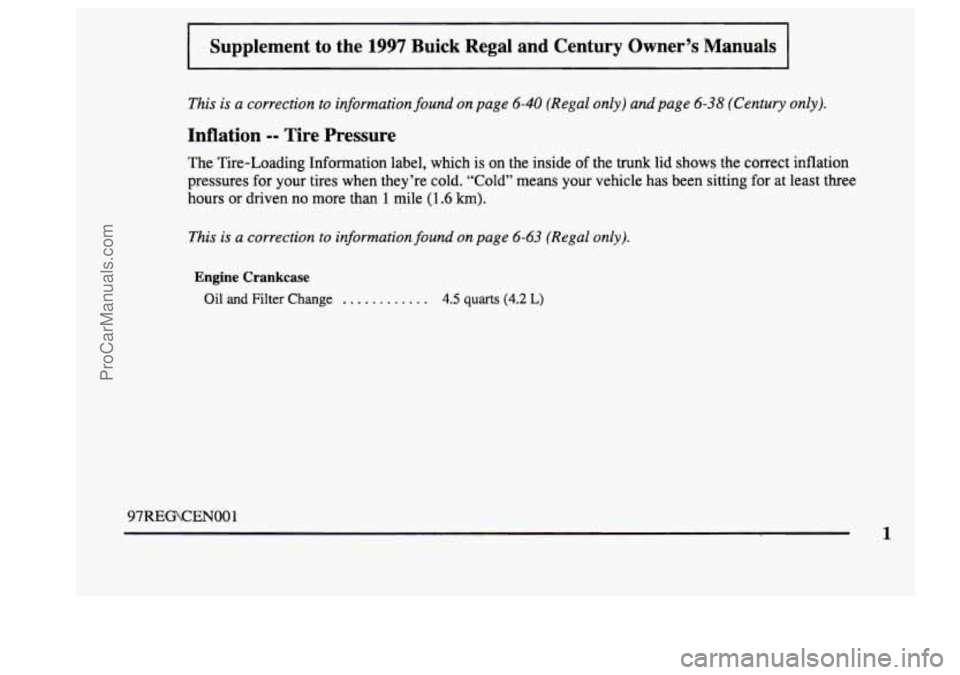
I Supplement to the 1997 Buick Regal and Century Owner’s Manuals
This is a correction to information found on page 6-40 (Regal only) and page 6-38 (Century only).
Inflation -- Tire Pressure
The Tire-Loading Information label, which is on the inside of \
the trunk lid shows the correct inflation
pressures for your tires when they’re cold.
“Cold” means your vehicle has been sitting for at least three
hours or driven no more than
1 mile (1.6 km).
This is a correction to information found on page 6-63 (Regal only).
Engine Crankcase
Oil and Filter Change . . . . . . . . . . . . 4.5 quarts (4.2 L)
97RECKEN001
1
ProCarManuals.com
Page 214 of 406
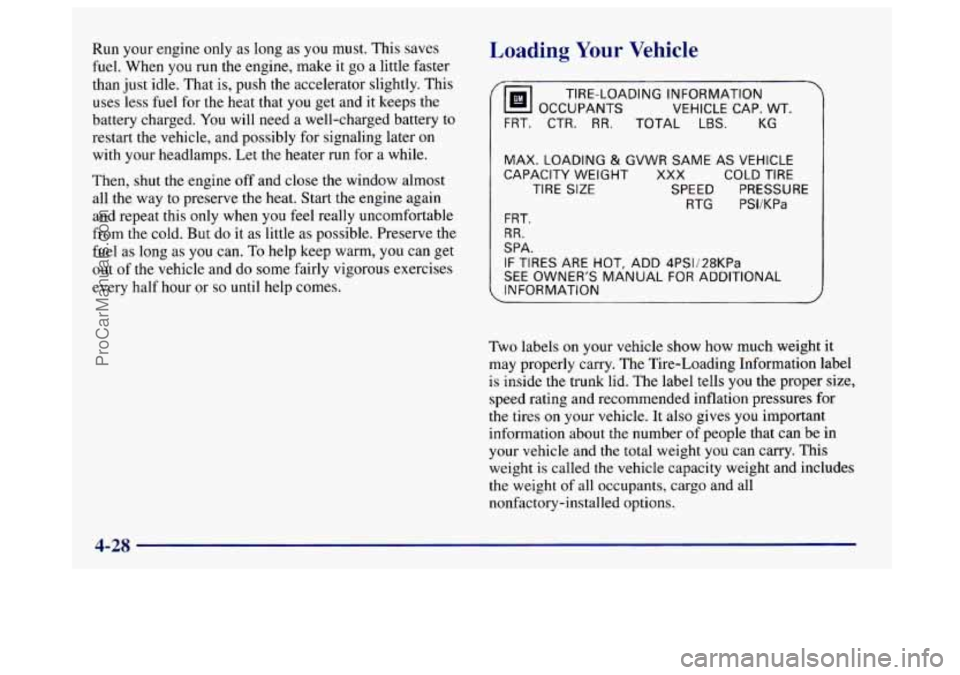
Run your engine only as long as you must. This saves
fuel. When you run the engine, make it go a little faster
than just idle. That is, push the accelerator slightly. This
uses less
fuel for the heat that you get and it keeps the
battery charged. You will need a well-charged battery to
restart the vehicle, and possibly for signaling later
on
with your headlamps. Let the heater run for a while.
Then, shut the engine
off and close the window almost
all
the way to preserve the heat. Start the engine again
and repeat this only when you feel really uncomfortable
from the cold. But
do it as little as possible. Preserve the
fuel as long as you can.
To help keep warm, you can get
out
of the vehicle and do some fairly vigorous exercises
every half hour or
so until help comes.
Loading Your Vehicle
TIRE-LOADING INFORMATION
VEHICLE CAP. WT.
FRT. CTR.
RR. TOTAL LBS.
MAX. LOADING & GVWR SAME AS VEHICLE
CAPACITY WEIGHT
XXX COLD TIRE
TIRE
SIZE SPEED PRESSURE RTG PSI/KPa
FRT.
RR.
SPA. IF TIRES ARE
HOT, ADD 4PSIi28KPa
SEE OWNER'S MANUAL
FOR ADDITIONAL
INFORMATION
Two labels on your vehicle show how much weight it
may properly carry. The Tire-Loading Information label
is inside the trunk lid. The label tells you the proper size,
speed rating and recommended inflation pressures for
the tires
on your vehicle. It also gives you important
information about the number of people that can
be in
your vehicle and the total weight you can carry. This
weight
is called the vehicle capacity weight and includes
the weight of all occupants, cargo and all
nonfactory-installed options.
4-28
ProCarManuals.com
Page 263 of 406
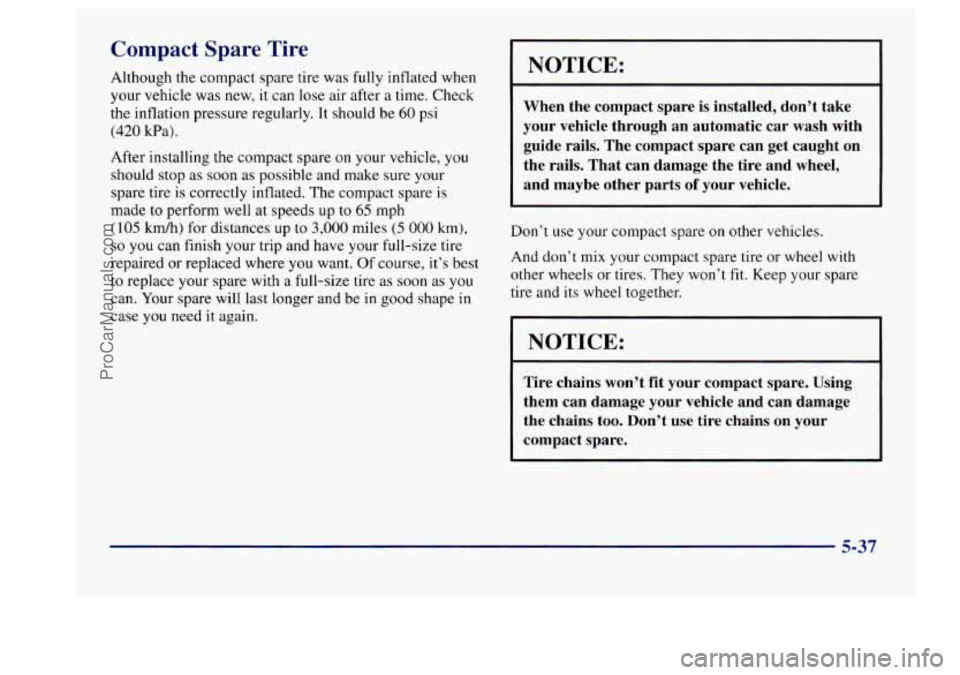
Compact Spare Tire
Although the compact spare tire was fully inflated when
your vehicle was new, it can
lose air after a time. Check
the inflation pressure regularly. It should be
60 psi
(420 kPa).
After installing the compact spare on your vehicle, you
should stop as soon as possible and make sure your
spare tire is correctly inflated. The compact spare
is
made to perform well at speeds up to 65 mph
(105 km/h) for distances up to 3,000 miles (5 000 km),
so you can finish your trip and have your full-size tire
repaired or replaced where you want. Of course, it’s best
to replace your spare with a full-size tire as soon as you
can. Your spare will last longer and be in good shape
in
case you need it again.
NOTICE:
When the compact spare is installed, don’t take
your vehicle through an automatic car wash with
guide rails. The compact spare can get caught on
the rails. That can damage the tire and wheel,
and maybe other parts
of your vehicle.
Don’t use your compact spare on other vehicles.
And don’t mix your compact spare tire or wheel with
other wheels or tires. They won’t
fit. Keep your spare
tire and its wheel together.
I NOTICE:
Tire chains won’t fit your compact spare. Using
them can damage your vehicle and can damage
the chains too. Don’t use tire chains
on your
compact spare.
5-37
ProCarManuals.com
Page 304 of 406
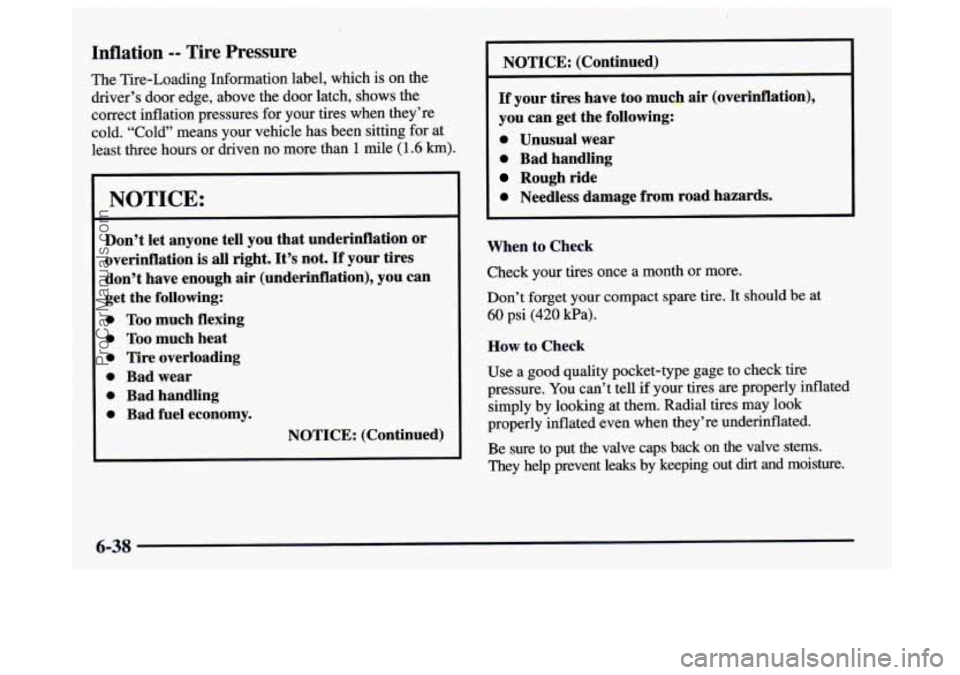
Inflation -- Tire Pressure
The Tire-Loading Information label, which is on the
driver’s door edge, above the door latch, shows the
correct inflation pressures for your tires when they’re
cold. “Cold” means your vehicle has been sitting for at
least three hours
or driven no more than 1 mile (1.6 km).
NOTICE:
Don’t let anyone tell you that underinflation or
overinflation
is all right. It’s not. If your tires
don’t have enough
air (underinflation), you can
get the following:
0 Too much flexing
0 Too much heat
0 Tire overloading
0 Bad wear
0 Bad handling
0 Bad fuel economy.
NOTICE: (Continued) NOTICE: (Continued)
If your tires
have too much air (overinflation),
you can get the following:
0 Unusual wear
0 Bad handling
Rough ride
0 Needless damage from road hazards.
When to Check
Check your tires once a month or more.
Don’t forget your compact spare tire. It should be at
60 psi (420 Pa).
How to Check
Use a good quality pocket-type gage to check tire
pressure. You can’t tell
if your tires are properly inflated
simply by looking at them. Radial tires may look
properly inflated even when they’re underinflated.
Be sure to put the valve caps back on the valve stems.
They help prevent leaks by keeping out
dirt and moisture.
ProCarManuals.com
Page 305 of 406

Tire Inspection and Rotation
Tires should be rotated every 6,000 to 8,000 miles
(10 O00 to 13 OOO km). Any time you notice unusual wear,
rotate your tires as soon as possible and check wheel
alignment.
Also check for damaged tires or wheels.
See “When It’s Time for New Tires” and ‘Wheel
Replacement” later
in this section for more information.
The purpose of regular rotation is to achieve more
uniform wear for all tires on the vehicle. The first
rotation is the most important. See “Scheduled
Maintenance Services” in the Index for scheduled
rotation intervals. Don’t include the compact spare tire
in your tire rotation.
After the tires have been rotated, adjust the front and
rear inflation pressures as shown
on the Tire-Loading
Information label. Make certain that all wheel nuts
are properly tightened. See “Wheel Nut Torque”
in the Index.
Rust or dirt on a wheel, or on the parts to which
it is fastened, can make wheel nuts become loose
after a time. The wheel could come
off and cause
an accident. When you change a wheel, remove
any rust or dirt from places where the wheel
attaches to the vehicle. In an emergency, you can
use a cloth or a paper towel to do this; but be
sure to use
a scraper or wire brush later, if you
need to, to get all the rust or dirt off. (See
“Changing
a Flat Tire” in the Index.)
When rotating your tires, always use the correct rotation
pattern shown here.
.. ~ 6-39
ProCarManuals.com
Page 367 of 406
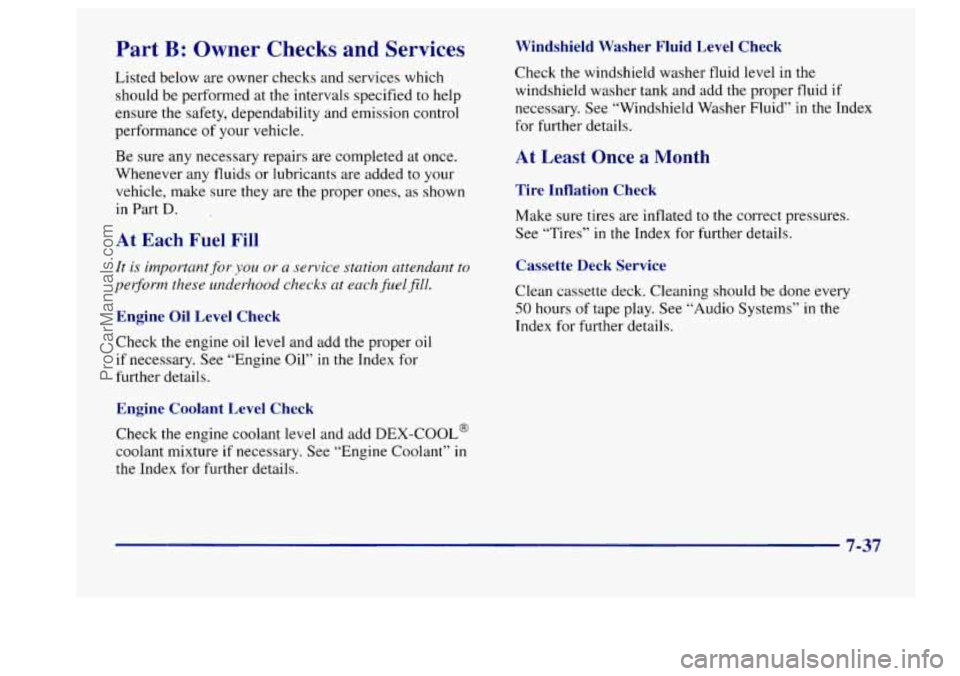
Part B: Owner Checks and Services
Listed below are owner checks and services which
should be performed at the intervals specified
to help
ensure the safety, dependability and emission control
performance of your vehicle.
Be sure any necessary repairs are completed at once.
Whenever any fluids or lubricants are added to your
vehicle, make sure they are the proper ones, as shown
in Part
D.
At Each Fuel Fill
It is important for you or a service station attendant to
pegorm these underhood checks at each fuel fill.
Engine Oil Level Check
Check the engine oil level and add the proper oil
if necessary. See “Engine Oil” in the Index for
further details.
Engine Coolant Level Check
Check the engine coolant level and add DEX-COOL@
coolant mixture
if necessary. See “Engine Coolant” in
the Index for further details.
Windshield Washer Fluid Level Check
Check the windshield washer fluid level in the
windshield washer tank and add the proper fluid if
necessary. See “Windshield Washer
Fluid” in the Index
for further details.
At Least Once a Month
Tire Inflation Check
Make sure tires are inflated to the correct pressures.
See “Tires”
in the Index for further details.
Cassette Deck Service
Clean cassette deck. Cleaning should be done every
50 hours of tape play. See “Audio Systems” in the
Index for further details.
7-37
ProCarManuals.com
Page 402 of 406

Tail/Stop/Turn Signal Lamp Bulb Replacement ...... 6-33
TapePlayerCare
............................... 3-35
Temperature Control
............. 3-2, 3-4, 3-5, 3-7, 3-8
Theft ......................................... 2-15
Theft-Deterrent Feature .......................... 3-3 I
Theft-Deterrent System .......................... 2- I6
THEFTLOCK TM ................................ 3-3 I
Thermostat .................................... 6-23
Third Gear, Automatic Transaxle
................... 2-24
Tilt Steering Wheel
............................. 2-33
Time, Setting the
............................... 3-12
Tire-Loading Information Label
................... 4-28
Buylng New
................................. 6-40
Changing
a Flat .............................. 5-25
Cleaning
.................................... 6-52
Compact Spare
............................... 5-37
Inspection and Rotation
........................ 6-39
Storing the Flat
............................... 5-35
Storing the Spare
............................. 5-36
Temperature
................................. 6-42
Traction
.................................... 6-42
Treadwear
................................... 6-42
Uniform Quality Grading
....................... 6-41
Wear Indicators
.............................. 6-40
Wheel Replacement
........................... 6-43
When It’s Time for New
....................... 6-40
Tires
........................................... -37
Alignment and Balance
........................ 6-43
Chains
..................................... 6-44
Inflation
.................................... 6-38
Inflation Check ............................... 7-37
Loading
.................................... 4-28
Pressure
.................................... 6-38
TopStrap ..................................... 1-50
TorqueLock
................................... 2-29
Torque. Wheel
Nut ......................... 5-34. 6.62
Towing
a Trailer ................................ 4-30
Towing Your Vehicle
............................. 5-9
Trailer BackingUp
................................. 4-35
Brakes
..................................... 4-34
Driving on Grades
............................ 4-36
Driving
with ................................. 4-34
Following Distance
........................... 4-35
If You Decide to Pull A ........................ 4-31
Maintenance When Towing
..................... 4-37
Parking on Hills
.............................. 4-36
Safety Chains
................................ 4-34
Tongue Weight
............................... 4-32
Total Weight on Tires
.......................... 4-33
Hitches
..................................... 4-33
MakingTurns
................................ 4-35
Passing
..................................... 4-35
Towing
..................................... 4-30
Turnsignals
................................. 4-36
Weight
..................................... 4-32
When You Are Ready to Leave After Parking
onaHill
.................................. 4-37
Automatic
................................... 6-17
Transmitters, Remote Keyless Entry ............ 2-9, 2-12
Transportation, Courtesy
.......................... 8-6
Trip, Before Leaving on a Long
.................... 4-21
Trip Odometer
................................. 2-55
Trunk
........................................ 2-14
Trunk Lid Appliaue
Bulb Replacement .............. 6-34
Lock ....................................... 2-15
9-10
ProCarManuals.com